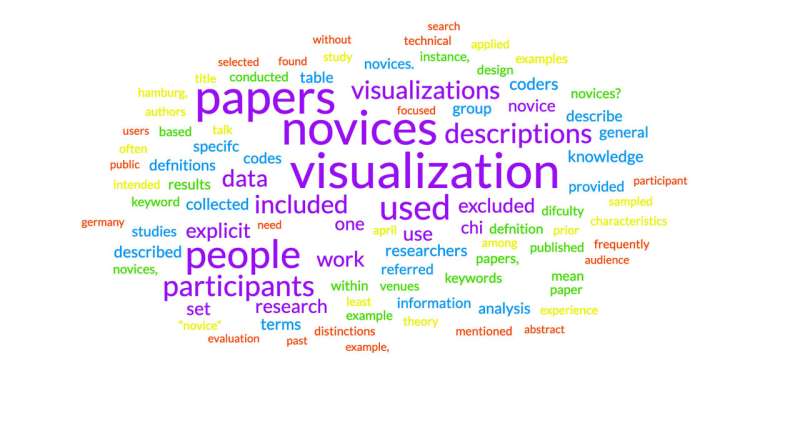This article has been reviewed according to Science X's editorial process and policies. Editors have highlighted the following attributes while ensuring the content's credibility:
fact-checked
trusted source
proofread
Know your audience: Why data communication needs to pay attention to novice users

Computer scientists at the University of Massachusetts Amherst recently found that data-visualization experts have no agreed-upon understanding of who makes up one of their largest audiences—novice users. The work, which recently won a coveted Best Paper Award at the Association for Computing Machinery's conference on Human Factors in Computing Systems (ACM CHI), is an important first step in ensuring more inclusive data visualizations, and thus data visualization that works for all users.
Data visualization is the representation of data in a visual and easily understandable way using common graphics such as charts, plots, infographics and animations. Using visual elements provides an accessible way to see and understand trends, outliers and patterns in data. One of the most familiar data visualizations—the pie chart—is legible to nearly everyone and has been a method used to quickly convey information since its invention in the early nineteenth century.
But, with the advent of the internet, the range, reach and complexity of such visualizations have grown exponentially. Think of the various online COVID trackers, graphics showing economic projections or the outcomes of national elections. "More and more, everyday people are relying on data visualizations to make decisions about their lives," says Narges Mayhar, assistant professor in the Manning College of Information and Computer Science at UMass Amherst, and the paper's senior author.
"Even many of our collective decisions rest on data visualizations."
Since a visualization's use is dependent on its intelligibility, one would think that data visualization experts would have a clear and standard understanding of their audience, particularly their non-expert users.
And yet, "despite many decades of data-visualization research, we had no clear notion of what makes someone a 'novice,'" says Mayhar. This insight was important enough that the ACM CHI, the premier international conference for human-computer interaction, bestowed the Best Paper Award on the research, an honor reserved for the top 1% of submitted papers.
Mayhar, lead author Alyxander Burns, who completed the research as part of his graduate studies at UMass Amherst, and their co-authors combed through the past 30 years of visualization research and found 79 papers spread across seven academic journals that concerned themselves with identifying the audience for data visualizations.
Within those 79 papers, they found that the definitions of a novice user ranged widely, from people who have difficulty "effectively utilizing GPU clusters" to those who lack knowledge of "ontological models." Moreover, the team found that most researchers' sample groups of users overwhelmingly skewed toward white, college-aged people living in the U.S.
"How do we know that the visualizations we create could work for older people, for those without college degrees, for people living in one of the world's many other countries?" asks Mayhar. "We need to be clear, as a field, what we mean when we say 'novice,' and the goal of this paper is to change the way that visualization researchers think about novices, address their needs and design tools that work for everyone."
More information: Alyxander Burns et al, Who Do We Mean When We Talk About Visualization Novices?, Proceedings of the 2023 CHI Conference on Human Factors in Computing Systems (2023). DOI: 10.1145/3544548.3581524
















